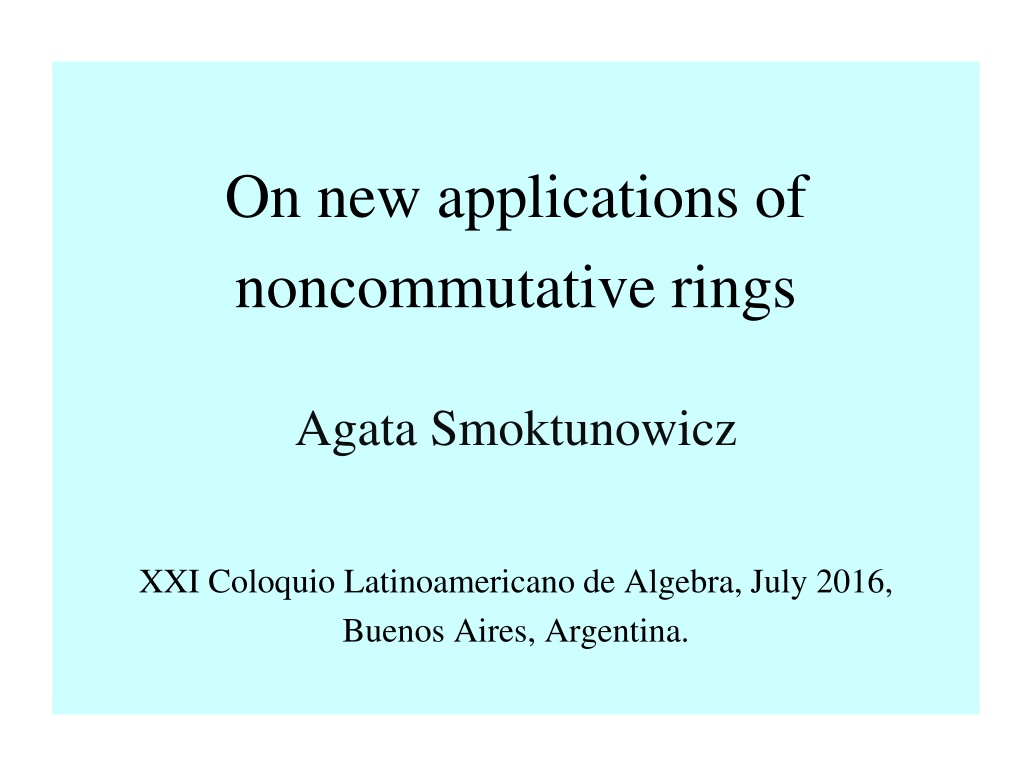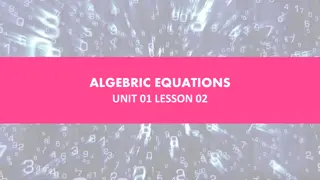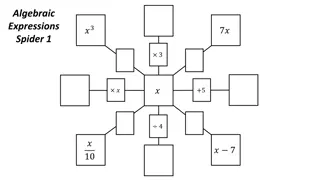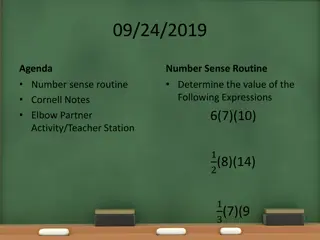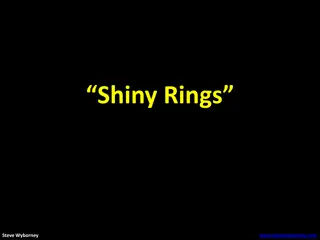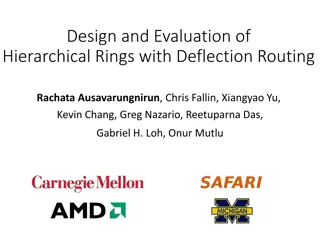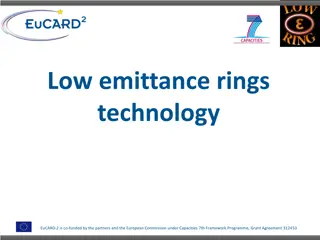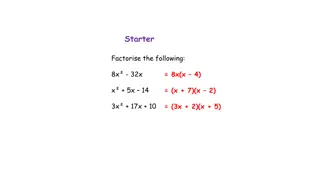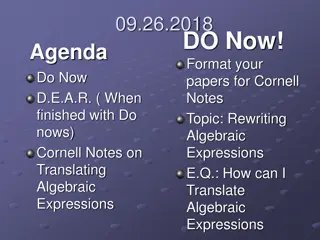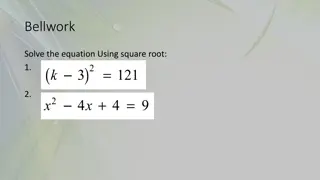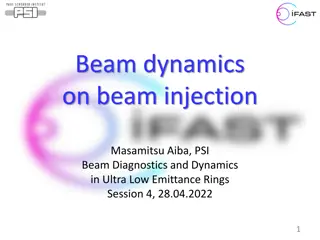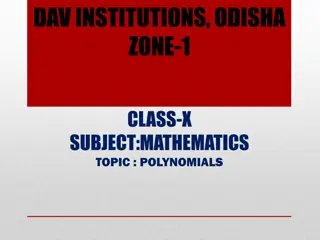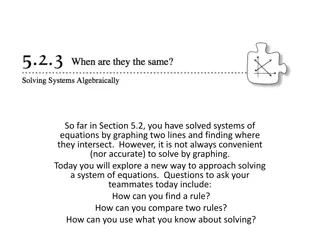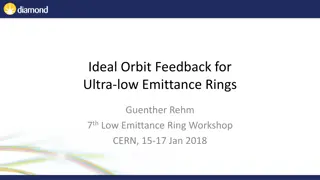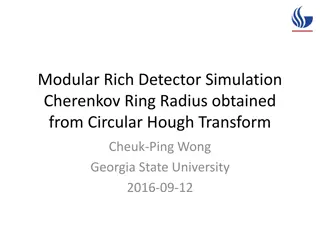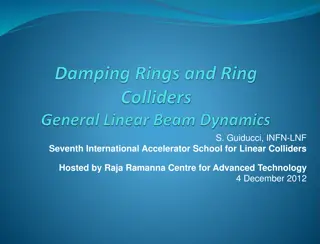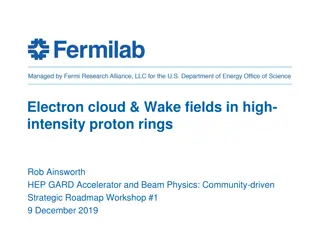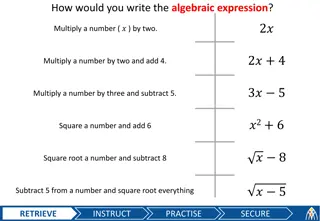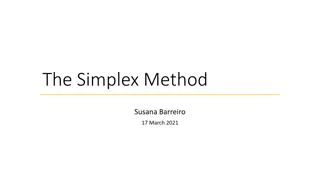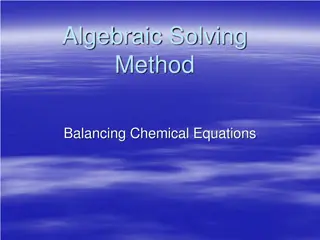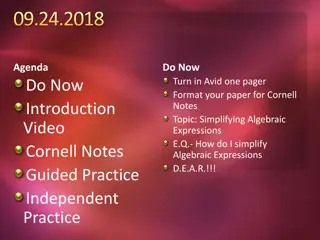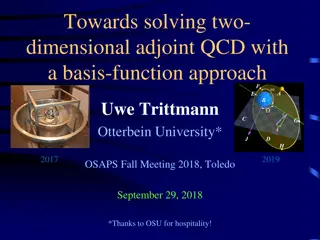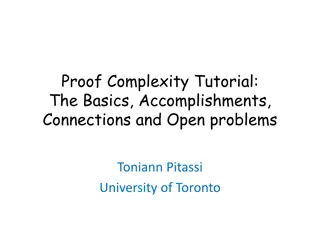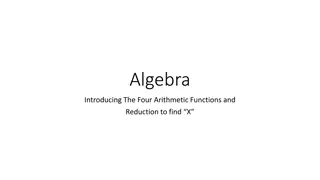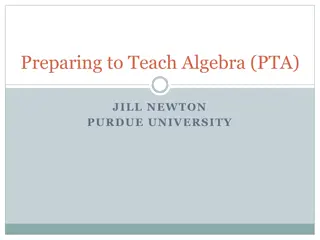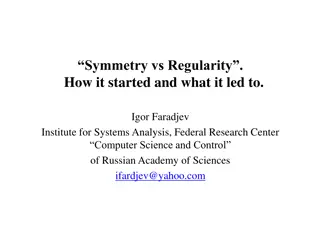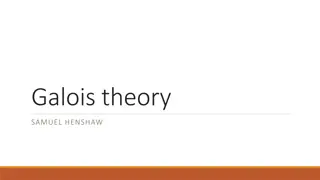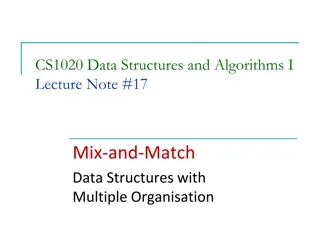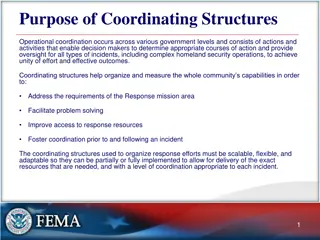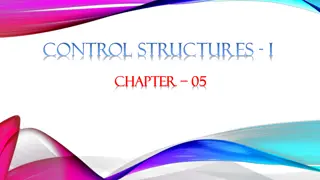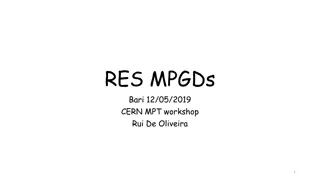New Applications of Noncommutative Rings in Algebraic Structures
Explore the novel applications of noncommutative rings in various areas such as geometry, differential polynomial rings, braces, and more, presented by Agata Smoktunowicz at the XXI Coloquio Latinoamericano de Algebra. Discover how these structures can be described and studied through generators, relations, and advanced mathematical methods.
Download Presentation

Please find below an Image/Link to download the presentation.
The content on the website is provided AS IS for your information and personal use only. It may not be sold, licensed, or shared on other websites without obtaining consent from the author. Download presentation by click this link. If you encounter any issues during the download, it is possible that the publisher has removed the file from their server.
E N D
Presentation Transcript
On new applications of noncommutative rings Agata Smoktunowicz XXI Coloquio Latinoamericano de Algebra, July 2016, Buenos Aires, Argentina.
Agata Smoktunowicz. University of Edinburgh, Edinburgh, Scotland, UK This research was supported by ERC Advanced grant 320974
Outline 1. Acons and applications in geometry 2. Differential polynomial rings and tensor products 3. Braces and nilpotent rings 4. Yang-Baxter equation 5. Groups and braces
Motivation Over the last decade there has been a series of new ideas of how to describe properties of certain structures in geometry using noncommutative rings such as reconstruction algebras, MMAs and Acons. These rings can be described via generators and relations, and they can be studied using Gold-Shafarevich theorem and other methods coming from noncommutative ring theory.
Acons and potential algebras Potential algebras and their versions appear in many different and related contexts in physics and mathematics and are known also under the names vacualgebra, Jacobi algebra, etc. Let K x, y be the free associative algebra in two variables, and F K x, y be a cyclically invariant polynomial. We assume that F starts in degree 3.
Potential algebras We consider the potential algebra A(F) , given by two relations, which are partial derivatives of F, i.e. A(F) is the factor of K x, y by the ideal I(F) generated by F/ x and F/ y , where for a monomial w: w / x = u if w = xu and 0 otherwise, w/ y = u if w = yu and 0 otherwise.
Example Let F=xxy+xyx+yxx be our superpotential Then F/ x =xy+yx and F/ y =xx. Then the potential algebra A(F)=K<x,y>/I Where I is the ideal generated by xy+yx and xx.
To understand the birational geometry of algebraic varieties via the minimal model program, it is necessary to understand the geometry of certain codimension two modifications known as flips and flops A central problem is to classify flips and flops in a satisfying manner, and to construct appropriate invariants. Donovan, Wemyss
We associate a new invariant to every flipping or flopping curve in a 3- dimensional algebraic variety, using noncommutative deformation theory. This generalises and unifies the classical invariants into one new object, the noncommutative deformation algebra Acon associated to the curve. It recovers classical invariants in natural ways. Moreover, unlike these classical invariants, Acon is an algebra. Donovan, Wemyss
Acons are potential algebras Acons are certain factors of MMAs- the maximal modification algebras (MMAs); they were developed by Iyama and Wemyss. If R is a 3-dimensional algebraic variety with MMA A, then by a result of Van den Bergh it follows that the relations of A come from a superpotential (under mild assumptions). Since Acon is a factor of A by idempotents, it too comes from a superpotential.
Questions of Wemyss The potential algebras that come from geometry are finitely dimensional. Wemyss asked several questions Question 1. What is the minimal dimension of an Acon? Question 2. What is the minimal dimension of a potential algebra? Question 3. Do all finitely dimensional potential algebras come from geometry as Acons? Wemyss et al. proved that rings coming from geometry have special central elements and are of a special form.
Some new results on Acons Theorem (N. Iyudu, A.S.) Let A(F) be a potential algebra given by a potential F having only terms of degree 5 or higher. Then the potential algebra A(F) is infinite dimensional and has exponential growth. Moreover, growth of a potential algebra whose potential F has only terms of degree 4 or higher can be polynomial. Question. If F has terms of degree 4 or higher, can the potential algebra A(F) be finite-dimensional?
Minimal degree of an Acon Theorem (N.Iyudu, A.S.) The dimension of every potential algebra is at least 8. Therefore, the dimension of every Acon is at least 8. M. Wemyss showed that the potential algebra (Acon) with F=xxy+xyx+yxx+xxx+yyyy has degree 9.
Some results on derivations and nil rings
Connections with differential polynomial rings Surprising applications of derivations in Lie algebras and nil algebras were found by L. Bartholdi, V. M. Petrogradsky, I.P. Shestakov and E. Zelmanov, for example to construct examples of graded nil Lie algebras of polynomial growth.
Nil algebra-every element to some power is zero. A ring R is Jacobson radical if for every a in R there is b in R such that a+b+ab=0 Nilpotent algebra-product of arbitrary n elements is zero (for some n).
The Jacobson radical The ring R/J(R) has zero Jacobson radical, so the Jacobson radical is useful for removing bad elements from a ring. Nathan Jacobson
Amitsurs result 1956 Let R be a ring, R[x] be the polynomial ring over R, and J(R[x]) its Jacobson radical. Then J(R[x])= I[x] for some nil ideal I of R. Shimson Amitsur
Possible generalizations Skew polynomial rings: Multiplication xr= (r)x. where is an authomorphism of R. Differential polynomial rings: Multiplication xr-rx=D(r). where D is a derivation of R.
Amitsurs result 1956 Let R be a ring, R[x] be the polynomial ring over R, and J(R[x]) its Jacobson radical. Then J(R[x])= I[x] for some nil ideal I of R. Shimson Amitsur
Bedi and Rams result (1980) Let R be a ring, be an authomorphism of R, and J( R[x, ]) denote the Jacobson radical of the skew polynomial ring R[x, ], then J( R[x, ]) =I[x, ] for some nil ideal I in R.
The Ferrero, Kishimoto, Motoose result (1983) Let R be a ring, and D be a derivation on R. Let J(R[x; D]) denotes the Jacobson radical of the differential polynomial R[x; D]. Then J(R[x; D]) =I[x; D] for some ideal I in R. Question. Is I nil?
The Ferrero, Kishimoto, Motoose result (1983) The Jacobson radical of the differential polynomial R[x; D] equals I[x; D] for some ideal I in R. Question: Is I always nil?
I is nil if 1. R is a commutative ring (Ferrero, Kishimoto, Motoose 1983). 2. R is PI algebra (Bergen, Montgomery, Passman 1983). 3. R is a Noetherian algebra (Jordan, 1975). 4. R is an algebra over an uncountable field (Ziembowski, A.S. 2013) 5. R is an algebra over a field of finite characteristic, and D is a locally nilpotent derivation (A.S. 2015)
A counterexample There exists a ring R which is not nil and a derivation D on R such that the differential polynomial ring R[x; D] is Jacobson radical. A.S.(2015)
A counterexample There exists a ring R which is not nil and a derivation D on R such that the differential polynomial ring R[x; D] is Jacobson radical. A.S.(2015) Moreover R can be an algebra over the algebraic closure of any finite field or its subfield.
Does it hold for algebras over other fields? Yes, provided that the following matrix-theory based question has affirmative answer
Matrix theory question Let F be a field. Let R be a semisimple finitely dimensional F- algebra, and let V be a generating space of R. Does it follow that the identity element of R belongs to Vnfor some n? Remark: it is true for some fields.
Some questions and related results Question 1. Let R be a ring without nil ideals, does it follow that J(R[x;D])=0? Question 2. Let R be a ring and D be a locally nilpotent derivation on R. Does it follow that J(R[x;D])=I[x] for some nil ideal I of R?
Answer to Shestakovs question Theorem (Ziembowski, A.S.) If R is a locally nilpotent ring and D is a derivation on R then the differential polynomial ring R[x; D] need not be Jacobson radical. Question (Nielsen, M.Z): What happens if R is a prime radical? Prime radical is the intersection of all prime ideals in a ring.
Two slides on Tensor products and some questions on Hopf algebras
Tensor product Theorem (A.S. 2014) Over any algebraically closed field there exists an affine infinitely dimensional nil algebra A such that the tensor product A A is nil. Theorem (Puczylowski 1988) If A is an algebra over an ordered field and A A is nil then A is locally nilpotent.
Open Question If R is a finitely generated Hopf algebra, does it follow that the Jacobson radical of R is locally nilpotent? Are nil ideals in R nilpotent? Is it true if R is an algebra over an ordered field?
In 2007 Rump introduced braces as a generalization of radical rings related to non-degenerate involutive set-theoretic solutions of the Yang-Baxter equation. ``With regard to the property that A combines two different equations or groups to a new entity, we call A a brace Wolfgang Rump Recently skew-braces have been introduced by Guarnieri and Vendramin to describe all non-degenerate set- theoretic solutions of the Yang-Baxter equation.
In the first part of this talk we will present some classical results of this area, mainly due to Rump. An excellent survey on this research area and new interesting results can be found in the paper by F. Cedo, E. Jespers and J. Okni ski, Braces and the Yang-Baxter equation, Communication in Mathematical Physics (arXive version is more extended).
Definition. A left brace is a set G with two operations + and such that (G,+) is an abelian group, (G, ) is a group and a (b+c) + a = a b + a c for all a, b, c G. We call (G,+) the additive group and (G, ) the multiplicative group of the right brace.
A right brace is defined similarly, replacing condition a (b+c)+a=a b+a c by (a+b) c + c = a c + b c. A two-sided brace is a right and left brace.
Nilpotent ring-product of arbitrary n elements is zero (for some n).
NILPOTENT RINGS Levitzki s theorem. Every finite nilpotent ring is a subring of a ring of strictly upper triangular matrices over a field.
NILPOTENT RINGS AND BRACES Let N with operations + and be a nilpotent ring. The circle operation on N is defined by a b = a b + a + b Finite two-sided braces are exactly nilpotent rings with operations + and . Intuition: (a+1) (b+1)=(a b+a+b)+1
Example. Let N be a strictly upper triangular matrix ring over the field of 2 elements. Then N has exactly 2 elements- 0 and element 0 1 r = 0 0 Then (N, +, ) is a two-sided brace with the same addition, 0=0+0=r+r and r=r+0=0+r and with the circle operation r r=r r+r+r=0, r 0 =r 0+r+0=r, 0 r =0 r+r+0=r, 0 0 =0 0+0+0=0
FINITE NILPOTENT RINGS ARE TWO-SIDED BRACES Let (N, +, ) be a nilpotent ring. Then (N, +, ) is a brace: * (N, +) is an abelian group * a (-a+aa-aaa+aaaa- .)=0 and a 0 =a 0 =a Therefore (N, ) is a group with the identity element 0. * a (b+c)+a = a(b+c)+a+b+c+a = a b+a c
THE SMALLEST LEFT BRACE WHICH IS NOT A TWO- SIDED BRACE HAS 6 ELEMENTS. Leandro Vendramin developed programms for GAP and Magma which produce all braces of given size. It works quickly for sizes <100.
SET-THEORETIC SOLUTIONS OF THE YANG-BAXTER EQUATION ``It is more or less possible to translate all problems of set-theoretic solutions to braces ``The origin of braces comes to Rump, and he realised that this generalisation of Jacobson radical rings is useful for set-theoretic solutions. David Bachiller (Algebra seminar, UW, 2015)
Let R be a nilpotent ring; then the solution (R; r) of the Yang-Baxter equation associated to ring R is defined in the following way: for x; y R define r(x; y) =(u; v), u = x y + y, v = z x + x where and z =-u+u2 -u3 + u4-u5+... If R is a left brace r(x,y) is defined similarly: u= x y-x and v= z x-z where z u = 0. This solution is called the solution associated with the brace R.
It is known (from Rump) that every non-degenerate involutive set-theoretic solution of the Yang-Baxter equation is a subset of a solution associated to some brace B, and hence is a subset of some brace B. Remark: A finite solution is a subset of some finite brace (Cedo, Gateva-Ivanova, A.S, 2016).
Another interesting structure related to the Yang-Baxter equation, the braided group, was introduced in 2000, by Lu, Yan, Zhu. In 2015, Gateva-Ivanova showed that left braces are in one-to-one correspondence with braided groups with an involutive braiding operator. Braces and braided groups have different properties and can be studied using different methods.
